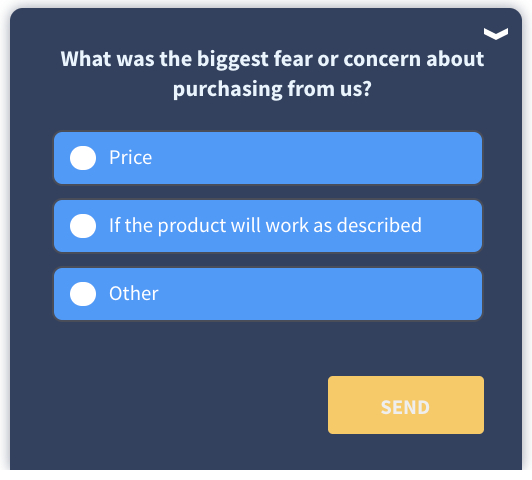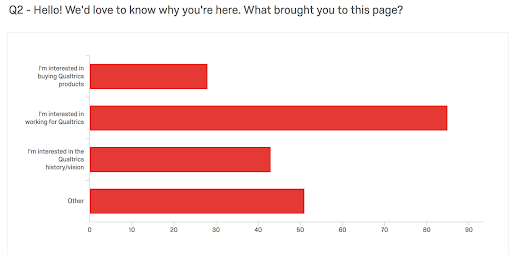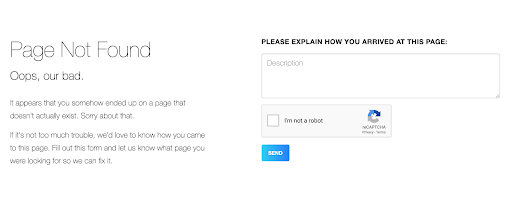Conversion Rate Optimization (CRO) is becoming big business in the digital marketing space.
Testing platforms are raking in big funding, including Optimizely recently raising $127 million! As practitioners are unlocking more revenue for their companies through the practice, the CRO toolset is growing.
The primary tool always is an experimentation platform to serve A/B testing. Outside of a testing platform, a suite of research tools are available. These tools include digital analytics, heat maps, user research, and website feedback surveys.
How to use website feedback surveys for CRO insights
Using website surveys for CRO insights is an innovative way to track your pages' conversion rate. The following seven examples show how leveraging website surveys will help you find your next winning test idea!
7 ways to use website surveys to get CRO insights
- Uncover checkout abandonment issues
- Find visitor intent of a page so you can optimize for it
- Passive bug bashing
- Gather website feedback from 404 pages
- Recruit user testing panels
- Capture feedback from support teams to highlight gaps in content
- Track overall website satisfaction as a long-term goal or benchmark
1. Uncover checkout abandonment issues
Do you suffer from below average conversion funnel completion rates? These rates may be low in the more traditional e-commerce checkout sense, or even an application process for lead generation sites. Using funnel reports in web analytics tools such as Google Analytics is a great start to understand which step in your funnel has the lowest conversion rate, where it comes short, and why it's the lowest. Using an exit intent website intercept survey can help you ask the users why they are abandoning the items they are initially intent on purchasing.
 Image courtesy of Qualaroo
Image courtesy of Qualaroo
An exit intent survey like this highlights issues that a standard error message doesn’t, such as your phone number field requiring better formatting,. These types of surveys have an immediate impact on your revenue by optimizing the last step in the user journey.
2. Find visitor intent of a page so you can optimize for it
Do you have a page that you don't know why people visit? This happened to us as we were redesigning our navigation last year. We didn't know why people went to our “About” page. We had a few different theories and turned to a website intercept survey on that page to ask our users exactly what the intent behind their visits were.


We concluded from our findings that visitors to this page were either job seekers, prospective clients, or were wondering, “who the heck is Qualtrics.” It turned out, it was a mix of all three of these types of people, but the biggest audience was job seekers. To cater to the largest segment of visitors to this page, we used the page to showcase our culture and history.
This survey let us know who exactly was coming to our page and for what reasons they were coming, which in turn helped us optimize their experience. Remember that regardless of how you distribute your survey, you still need to use best practices of survey design.
3. Passive bug bashing
Typically, there are a lot more customers and prospects using your site than employees. However, most companies only give instructions on how to report bugs to employees. Instead, why not turn all those users into a bug bashing army? We always have a “website feedback” tab on our site. The feedback we receive from visitors using this tab pipes directly into a Slack channel in addition to the typical survey reporting. This passive feedback helps us find typos, broken pages, and misinformation rapidly. We find new issues a few times a week, especially on deeper pages that we don't often visit.
Capture browser information in the metadata of the survey so you can use that to recreate issues, and so you can blame your web browser for all your bugs.
4. Gather website feedback from 404 pages
If you have 404 errors tracking as custom events with alerts in your analytics tool (which you should), you’ll see what URL people are trying to access unsuccessfully. Figuring out how they got to the 404 page is a whole other challenge depending on the tracking you may or may not have. Why not just ask users to tell you how they arrived right in your 404 page?

5. Recruit user testing panels
Need to find some customers or prospects to provide your product or website feedback? Why not interview the people that you already know are users? By popping out a website survey, you can ask if people are interested. Then, use follow-up survey question to capture their contact information.
6. Capture feedback from support teams to highlight gaps in content
If you have a digital customer support option like chat or email, you can use a post-interaction satisfaction survey to understand what issues users are having most often. Look for opportunities to create additional help content or highlight common resolutions in the process of a user requesting support.
7. Track overall website satisfaction as a long-term goal or benchmark
From our experience, almost half of our tests do not deliver conclusive results. Inconclusive tests happen when your tests did not reach statistical significance for your primary metric (either by improving or decreasing.) So what do you do in these cases where you don't have a clear winner? A lot of the time, your test might be a feature that your team feels like is an improvement to the user or brand experience on your website, even if it doesn't change your conversion rate. I believe you should go with your gut when the data doesn't prove out.
Measuring overall satisfaction on your site over the quarters and years is a great way to see if your site is getting better or worse in the eyes of your users. Remember, there is a difference between pleasant and effective user experience.
Why do you think Neil Patel’s site has four exit-intent pop-ups in a row? Users hate them, but they work! Use satisfaction scores as a way to make sure you aren't annoying your customers in the name of conversions.
The sky's the limit
These are just a few common ways you can use website feedback surveys to improve your website and cloud software product. A foundational thought process to find more creative ways to use them is to look at the data that tells you “what” is happening like bounce rate, conversion rate or excess time on page and use a website survey to ask the user why.
Want to learn more about customer feedback? Read out guide on customer reviews!
 by Michael Gigante
by Michael Gigante
 by Jared Gardner
by Jared Gardner
 by Gaetano DiNardi
by Gaetano DiNardi